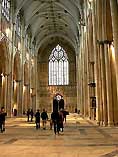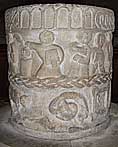Architecture and theology: are they sermons in stone, always relevant?
When viewing any religious building there are, strangely, very scientific (i.e.
mathematical) forces at play. The whole of the universe seems to have been constructed round certain
mathematical principles. I am thinking of what we now know as the Fibonacci series and its co-relate, the Golden
Mean. The Fibonacci series is arrived at by adding successive and sequential numbers together as in
1,2,3,5,8,13,21,34,55 etc. Although the credit is given to a 13th century Italian, the observation is first thought
to have been discovered in India some 1,000 years before. Its co-relate is the Golden Mean in that if one divides
each of the numbers by its predecessor then the higher up the Fibonacci sequence one goes the figure closely
approximates to that derived from the Greek discovery of the geometrical shape of the Golden Mean ( dividing a line
in 2 so that the ratio between the larger and smaller is identical to the ratio of the whole line to the larger
segment).
A___________________B_________C (The ratio of AB to BC, is the same as AC to AB.)
This ratio is
1.618. This has enormous significance in that these proportions are found throughout creation. It is found in the
petals of flowers, branches of trees, pattern of leaves, pine cones. The ratio is found in the human body. Each of
our hands with three bones to each of five digits express this ratio, as does the length of each of the bones in a
single finger. The belly-button also divides the height of the human body into the Golden Ratio, as does the
construction of our faces, even our teeth. Surprisingly our DNA complies, with each molecule measuring 21 x 34
angstroms. 21 and 34 are neighbours in the Fibonacci series, thus the ratio between them is 1.61904. In the famous
Vitruvian Man, Leonardo da Vinci illustrated the shape of the human body when arms and legs are outstretched,
complying with this ratio. It is probable, then, that this Golden Ratio and the Fibonacci series so pervade Nature
and our experience of it that we subconsciously accept any vsible expression of it as perfect. In our terms they are
inherently aesthetic.
We see these geometric results particularly in
architecture. Many buildings, including the pyramids and the Parthenon in Greece, are thought to have
been constructed according to the Golden Mean. In church buildings we find a mix of this, coupled with history and
symbolism, and what is termed 'sacred geometry'. Many church buildings in the post Constantine period (after 320 CE)
were influenced, historically, by the decisions made by Constantine, one of which was that this new religion,
Christianity, empowered him to rule on earth while Christianity ruled in heavenly matters. As evidence of this it
was commonplace to build what we term basilicas (literally meaning royal tribunal chamber), the interiors often
reflecting that of the audience chamber of the emperor, i.e. very imposing and hierarchical, moreover a fitting
stage for the celebration of the mass/eucharist! Today there are more than 1500 churches deemed to be in this style,
each trying to recreate the power, influence and dominance implied by the original. Next in major influence was the
Gothic which started in France in the early medieval period. Typically they were built in cruciform shape with a
transept separating the nave (where the congregation were) from the chancel and the sanctuary. This represented the
hierarchy of position in the church with the crossing in the transept as the 'void' through which the faithful must
go to reach heaven (through communion in the sanctuary). Using ribbed vaults and flying buttresses Gothic buildings
had much more light, used for more stained glass to educate and impress the illiterate faithful. Another feature was
that of overall height, representing humanity reaching out to heaven. The entrance, at the west end, was also more
imposing, often complying with the Golden Mean. The overall effect was one of majesty, creating a powerful
impression on the incoming worshipper of the power of God but also that of the community which built it! The Notre
Dame de Paris is an excellent example of such construction.
Nor must we forget
sacred geometry, very often based on either numerology or more esoteric religions. Using no more than a
pair of compasses and a straight line the sophisticated cathedrals of the medieval period were constructed through
this form of active theology, 'active' in that it recreated certain fundamental beliefs regarding God and his
universe by enshrining them in stone both to sanctify the building and magically preserve them for ever. To the
medieval mind geometry was a divine activity because God had created the universe by using laws of geometry. To them
the earth was flat with 4 winds, 4 quarters, and 4 corners, while the sky appeared hemispherical. The sun which gave
light and life was circle. Thus their sacred world consisted of the circle and its derivatives, the hemisphere and
sphere, wherein was found God and eternity, while the square represented the earth where all humans lived and died
their impermanent existence. By combining these elements in cathedrals and churches, particularly surmounting the
building with a dome, or putting the high altar into an apse at the east end, they imagined God would see this,
approve and bless them. We think of these as symbols. For them it was magic which worked.
Consider the circular "rose" windows found in many cathedrals in Europe.The
circle represents heaven, God and eternity because it is a single perfect shape without beginning or ending. It is
interesting to note that the symbols found in many of these windows were often similar or identical to symbols found
in the zodiac - another ancient circle. The west rose window of Notre Dame in Paris features the Virgin Mary with
her child in the center (the point of perfect balance), surrounded by 24 fields. In addition to symbols for virtues,
vices, and prophets, all twelve signs of the zodiac are included in the window. This cross-over of pagan to
Christianity is also seen in the Cathedral of Lyon which seems to use the Chinese T'ai Chi or "yin-yang"
image at its center. Other rose windows use the cross at the center, and this is strikingly similar to the cardinal
points that were established in the sacred circles of many religions.
The Celtic
cross (basically the quartering of a circle) was probably pagan in origin, and represented the four
seasons, four positions of the sun, the four directions and four elements. It was subsequently adapted as a symbol
for Christianity, and, indeed many Christian churches were built on former places of worship for the Druids.
The halo, painted round the heads of many a saint and found from the 5th century
onwards, is said to derive from Buddhist and Greek use round the heads of particularly spiritual people
and dating at least 2 centuries earlier. Some think the halo represents the spiritual auror of the person while
others think of it as a sun symbol.
Then we have the more esoteric
inclusions. In London, for example, Nicholas Hawksmoor built 12 churches “based on the rules of the
Ancients”. He borrowed from Greek, Roman and Egyptian sources, and his buildings are full of obelisks, pyramids and
cubes beloved in occult circles, particularly the freemasons.
The most ancient
symbol of the Green Man, a combination of a human head with foliage and found across cultures and in all parts
of the world, is to be found in many a church or cathedral, often as gargoyles, ceiling bosses or column
capitals. Although he represents fertility and regeneration his stern countenance suggests that Nature, not man, is
the master on this planet, something our growing egocentricity would do well to remember. These pagan symbols were
often a strong feature of the early medieval church, when it is likely that ordinary people, including many a mason
had more faith in the old pagan ways than they did Christianity. The most amazing example I have come across is the
Norman church of Kilpeck in Herefordshire. The entrance door has an intricate series of carvings round it with
strong celtic and nordic influences, depicting dragons, snakes, angels, a lion, a phoenix, foliage, with the Lamb of
God above the doorway along with the tree of life and the inevitable green man, while the doorposts feature Welsn
warriors. Encircling the church, below the roof line, are over 80 corbels. Apart from Adam and Eve, Cain and Abel,
and the lamb of God, most of the symbols are of pagan origin, a dog, a bear, a ram, a hare, a juggler, wrestlers,
man playing a reebok, even a deer hung upside down!
This fusion of styles and
religions was common in medieval churches. Aesthetically we have much to learn from them. I have dwelt on
this period because with the arrival of the Renaissance the complexities of sacred geometry were more and more
ignored as life moved away from religion with the rise of a more secular society. Gradually architects and numbers
took over the construction detail and, true, wonderful aesthetic buildings were created (consider St Paul's
Cathedral). Yet somehow the complexity of the often hidden geometry of this fusion of differing religious ideas, the
combination of past, often timeless and mythical symbolism, in a Christian setting, this link of our long past with
ideas of heaven, all this, for me, has become more stylised, more demonstrative of modern humanity. We are more than
that. We are our past as well. It is inbuilt in us, psychologically. We are the Celtic cross. We are the Green Man.
We are the Zodiac. The journey of discovery in a building needs to unfold, to be discovered. A grandiose building of
the Renaissance period onwards may fill us with awe and wonder, but does it fill us with the subtleness, the
complexities, the evolving spirituality of our past which has enabled us to become what we are today?


